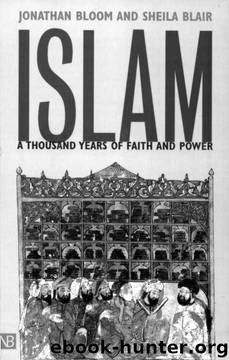Islam: A Thousand Years of Faith and Power (Yale Nota Bene) by Jonathan Bloom;Sheila Blair

Author:Jonathan Bloom;Sheila Blair
Language: eng
Format: epub
Published: 2010-04-09T20:57:00+00:00
in Arabic as 1, i', r, f, V, and i respectively-were rotated and changed into those "Arabic" numerals used almost universally today in the West. Other "Arabic" numerals, such as 5 and 6, were made by transforming the Roman numerals V and VI as they had been written in the Visigothic script used by Christians in Spain. The numeral 8, which bears no resemblance to the inverted "V" (A) used by the Arabs, came from an abbreviation of the Latin word octo ("eight"), when the last letter is written above the first.
At first Europeans were as reluctant as their Muslim brethren to adopt the new system of numeration, and for more than a century the algorists, who manipulated the new numerals on paper, struggled against the abacists, who preferred traditional calculation with counters. In 1202 the Pisan merchant Leonardo Fibonacci, who had learned about Arabic numerals in Tunis, wrote a treatise entitled Liber abaci ("The Book of Abacus [pieces]"). Despite its name, the book rejected the abacus in favor of the Arab method of reckoning, and as a result, the system of Hindu-Arabic numeration caught on quickly in the merchant communes of Central Italy. By the fourteenth century, Italian merchants and bankers had abandoned the abacus and were doing their calculations using pen and paper.
in addition to his treatise on numerals, the Abbasid mathematician al-Khwarizmi also wrote a revolutionary book on mathematics entitled Kitab al-mukhtasar fi hisab al jabr wa'I- muqabila ("The Book of Summary Concerning Calculation by Transposition and Reduction") in which he sought ways of resolving quadratic equations. The examples were given either as geometric demonstrations or as numerical proofs using an entirely new mode of expression, in which letters or words represented numerical values.
Al-Khwarizmi's work was widely known in the Islamic lands and soon translated into medieval Latin. The earliest known translation was made in 1145 by the Englishman Robert of Ketton. His translation of al-Khwarizmi's treatise on algebra, Liber Algebras etAlmucabola, opened with the words dixitAlgorithmi, "Algorithmi says." In time, the mathematician's epithet of his Central Asian origin, al-Khwarizmi, came in the West to denote first the new process of reckoning with Hindu-Arabic numerals, algorithmus, and then the entire step-by-step process of solving mathematical problems, algorithm.
Robert of Ketton's translation was followed shortly thereafter by that of the Toledan scholar Gerard of Cremona (c. 1114-1187) entitled De Jebra et Almucabola. The Arabic word for "transposition," al jabr, gave the entire process its name in European languages, algebra, which is understood today as the generalization of arithmetic in which symbols, usually letters of the alphabet such as A, B, and C, represent numbers. AlKhwarizmi had used the Arabic word for "thing" (shay) to refer to the quantity sought, the unknown. When al-Khwarizmi's work was translated in Spain, the Arabic word shay was transcribed as xay, since the letter x was pronounced as sh in Spain. In time this word was abbreviated as x, becoming the universal algebraic symbol for the unknown.
Although al-Khwarizmi's fame in the West was established
Download
This site does not store any files on its server. We only index and link to content provided by other sites. Please contact the content providers to delete copyright contents if any and email us, we'll remove relevant links or contents immediately.
The History of Jihad: From Muhammad to ISIS by Spencer Robert(2508)
Nine Parts of Desire by Geraldine Brooks(2283)
The Turkish Psychedelic Explosion by Daniel Spicer(2247)
The First Muslim The Story of Muhammad by Lesley Hazleton(2159)
The Essential Rumi by Coleman Barks(1931)
1453 by Roger Crowley(1881)
The Last Mughal by William Dalrymple(1796)
Trickster Travels: A Sixteenth-Century Muslim Between Worlds by Davis Natalie Zemon(1784)
Muhammad: His Life Based on the Earliest Sources by Martin Lings(1569)
God by Aslan Reza(1564)
by Christianity & Islam(1564)
A Concise History of Sunnis and Shi'is by John McHugo(1517)
Magic and Divination in Early Islam by Emilie Savage-Smith;(1459)
No God But God by Reza Aslan(1438)
The Flight of the Intellectuals by Berman Paul(1401)
Art of Betrayal by Gordon Corera(1366)
Nothing to Envy by Barbara Demick(1328)
What the Qur'an Meant by Garry Wills(1325)
Getting Jesus Right: How Muslims Get Jesus and Islam Wrong by James A Beverley & Craig A Evans(1276)
